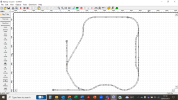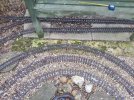I would echo the comment about using the widest curves you can for live steam. Our previous garden being larger, I relaid the railway to minimum of 1600mm radius, and 2400mm radius where I could. The exhibition layout I am a part of usually is 1700mm for running lines, and 1550mm radius for sidings, but we do run some quite big south African locos sometimes. Our current garden being smaller has a 800mm radius ballon loop which all my locos will run around quite happily, but they do slow down and sometimes need driving a little harder around the loop. Mine are all 0-4-0 or 0-4-2 wheel configuration, so if you are happy to stick to models of smaller prototypes then you should be OK. Certainly Roundhouse, Accucraft and Regner 0-4-0 locos will cope with 600mm radius albeit with the tendency to slow down or need some extra regulator on the tighter curves. Running on a smaller garden railway can be more fun and it does mean you can concentrate on your efforts so may well end up with a more detailed railway than if you had many acres to run in. On zooming in it does look like you have drawn 600mm radius curves, (what others have called R1 which only works if you know the maker as well, as they all seem to use different sizes for their R numbers for radius of track). Better to just use the measurement size. I tend to use 'flexible' track, partly as it is cheaper, but it also means you can ease into curves which will help trains run more smoothly, and hopefully stay on the track should a train be going a little too fast into a curve, not that any of us will ever do that on purpose, but sometimes a manual steam loco can get carried away. May I recommend looking at the 16mm association website and maybe contacting the Solihull/South B'ham 16mm local group (which covers most of B'ham now) some of whom hold regular steam ups and run on 45mm track, others run on 32mm track as they model 2' gauge. All the best with building your railway, we never regretted moving up to a larger scale and moving (mainly) to the garden, about 25 years ago.


